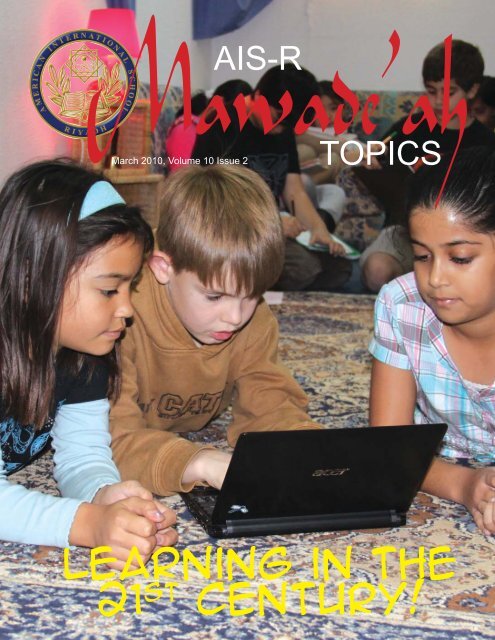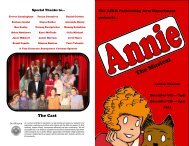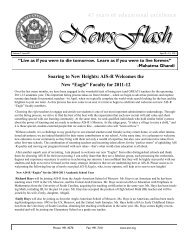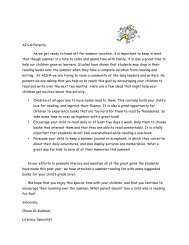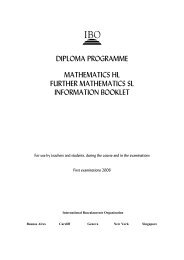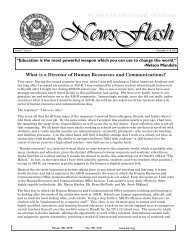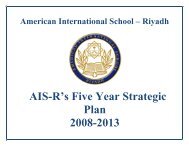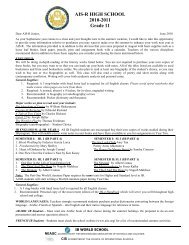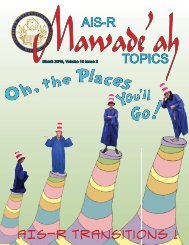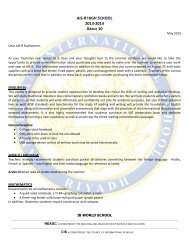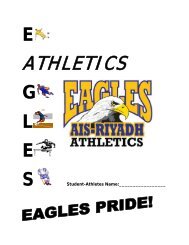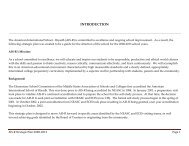Vol 10, Issue 2 - American International School - Riyadh
Vol 10, Issue 2 - American International School - Riyadh
Vol 10, Issue 2 - American International School - Riyadh
Create successful ePaper yourself
Turn your PDF publications into a flip-book with our unique Google optimized e-Paper software.
Mawade’ah<br />
AIS-R<br />
TOPICS<br />
March 20<strong>10</strong>, <strong>Vol</strong>ume <strong>10</strong> <strong>Issue</strong> 2<br />
Learning in the<br />
21 st Century!
AIS-R’s Mission<br />
As a school committed to excellence,<br />
we will educate and inspire our students to be responsible,<br />
productive and ethical world citizens with the skills and passion to<br />
think creatively, reason critically, communicate effectively and learn<br />
continuously. We will accomplish this in an <strong>American</strong> educational<br />
environment characterized by high measurable standards<br />
and a clearly defined, appropriately interrelated college<br />
preparatory curriculum, implemented by<br />
a superior staff in partnership with parents<br />
and the community.<br />
Mawade’ah means “topics” in Arabic. In this case, the name conveys the idea<br />
of topics that form an ongoing conversation about our school.<br />
Publisher:<br />
<strong>American</strong> <strong>International</strong> <strong>School</strong>-<strong>Riyadh</strong><br />
P.O. Box 990<br />
<strong>Riyadh</strong>, 11421 Saudi Arabia<br />
Phone: (9661) 491-4270<br />
Fax: (9661) 491-7<strong>10</strong>1<br />
Online:<br />
www.aisr.org<br />
Superintendent: ext. 235<br />
Registration: ext. 248/270<br />
Editors:<br />
Layout & Design:<br />
Jerri Myers<br />
and Kerri McGlade<br />
Joyce Mikhael Zammar<br />
2
Five Minds for<br />
the Future<br />
(Gardner<br />
er, 20<br />
09)<br />
The Disciplinary<br />
Mind<br />
—<br />
the mastery of<br />
majo<br />
r schools<br />
of thought,<br />
ht<br />
such<br />
as science,<br />
e,<br />
mathematics, atic<br />
and<br />
history, and of<br />
at least one<br />
area<br />
of professional<br />
expertise.<br />
The<br />
Synthesizing<br />
Mind—<br />
the ability to<br />
integrate t<br />
ideas<br />
from<br />
many<br />
disciplines<br />
ipli<br />
into<br />
coherent<br />
wholes and to<br />
communicate<br />
this to others.<br />
The Creating<br />
Mind—<br />
the capacity<br />
to unearth and<br />
explain<br />
ne<br />
w<br />
problems,<br />
questions and<br />
phenomena.<br />
ena.<br />
The Respectful<br />
Mind—<br />
the awareness aren<br />
ess of<br />
and appreciation<br />
pr<br />
for similarities<br />
and diff<br />
ffer<br />
eren<br />
ence<br />
ces<br />
among human<br />
be<br />
ings<br />
and<br />
human grou<br />
oups<br />
ps.<br />
The Ethical<br />
Mind—<br />
the fulfillment<br />
lment<br />
of one’s<br />
responsibilities<br />
as a world<br />
citizen.<br />
In This <strong>Issue</strong> ...<br />
Dear Friends of AIS-R,<br />
During the first decade of the 21 st century, educators renewed a dialogue about the ways<br />
in which people learn, based on a wealth of new research in the field. They also debated<br />
a range of adaptive skills and understandings that students require for future growth<br />
and success. With breakthroughs in cognitive science, innovations in technology,<br />
initiatives with online learning, advancements in social networking—to name a few—<br />
this conversation flourished and a general consensus has emerged in the literature that<br />
is strikingly straightforward: The principles of schooling must change. Educationalists<br />
(and futurists), therefore, are working toward deciphering the brave new possibilities of the future with an essential<br />
question: “How do we prepare students as life-long learners in a rapidly changing world”<br />
Researchers have begun to unpack the complexities of this question with a promising agreement about the critical<br />
understandings, skills, and dispositions that students require for learning success in the future—what many are<br />
calling 21 st Century Skills. In this literature, theorists emphasize that the learning processes essential for the future<br />
will need to be generative, authentic, cross-disciplinary and metacognitive; integrated skills such as creativity,<br />
problem-solving, innovation, critical thinking, and so forth, will be key. In his new book, Five Minds for the<br />
Future (2009), the renowned Harvard psychologist, Howard Gardner, asserts that the cognitive abilities required<br />
for generational viability are as follows: the Disciplinary, Synthesizing, Creating, Respectful and Ethical “minds”<br />
(see side panel). Gardner, among others, argues that educators must refocus their energies to develop these “habits<br />
of mind” in their students so that they will be able to learn continuously and adapt easily to a new world order<br />
that remains, at present, elusive. In other words, educators must shift their practice from established pedagogy to<br />
transformative instruction, focused on learning and higher level thinking skills, in order for students to respond<br />
appropriately no matter what is ahead for them in life.<br />
Over the past several years, this paradigm shift has been emerging in educational practice and educators at AIS-R<br />
(and beyond) have been expanding their repertoires to ensure that these indispensable skills are realized. Just the<br />
other day, for example, I visited a HS English classroom where I observed 21 st century learning in action. Here,<br />
students, in the midst of an assignment, arranged in cooperative groups—some at tables, some seated in a circle,<br />
some standing—were engaged in the learning process: dialoguing, debating, creating and collaborating. The<br />
assignment was to conceptualize Thomas Friedman’s book, The World is Flat (certainly relevant in the 21 st Century),<br />
and decide how to best share critical information that would demonstrate their learning—an oral presentation, a<br />
technology display, an interactive debate, and so forth. With initial criteria for the assignment discussed, the<br />
parameters were open and flexible and students were expected to negotiate, problem-pose and problem-solve;<br />
there were no exact answers assumed for this generative assignment. Instead, learners were challenged to develop<br />
(further) many of the habits so richly described by Gardner and as one student reflected: “By reading this book I’ve<br />
learned how far we’ve come and how fast technology is changing things. It’s exciting, but kind of scary.”<br />
Like Mike Kielkopf’s learning activity above, the authors of this edition of Mawade’ah are tackling some of the<br />
complexities of this important dialogue: Michael McGlade, Technology Director, sets the stage by defining and<br />
expanding the concept of 21 st Century Skills, especially in light of AIS-R’s Mission; Moiz Qureshi, an AIS-R student,<br />
mindfully discusses his MUN learning experience in Athens; Stuart Stephenson shares a cognitive scientist’s view<br />
about “getting smarter”; Layal Sayoud overviews progressive teaching and learning through “explicit modeling”;<br />
Roma Soni and her students share their creating experiences with contextualized art endeavors; Michelle Khoury<br />
sings about learning through music; David Johnson makes learning real; Saurabh Luthra empowers (and cherishes)<br />
young writers; and, Jason Inghram reminds us about the dynamic nature of a teacher’s job description. Here, our<br />
community of learners share their embedded experiences to demonstrate the emerging shift in educational practice.<br />
The complexity of how to best prepare students for success in the future is an imperative conversation that schools<br />
must have and this edition of Mawade’ah reinforces that we are immersed in this dialogue here at AIS-R. By<br />
staying attuned to educational trends, research and best practices we will continue to develop ourselves and build<br />
in students the habits of mind that are necessary for success today and in the future.<br />
At AIS-R, we are energized about the learning possibilities ahead and we hope that you will enjoy this edition of<br />
Mawade’ah.<br />
Learn with us!<br />
Dr. Brian Matthews<br />
AIS-R Superintendent<br />
3
4<br />
A Mission Driven Curriculum for<br />
21st Century Learners<br />
by : Michael McGlade<br />
As we enter the second decade of the 21 st<br />
century, schools worldwide continue<br />
to struggle with the challenge of teaching<br />
our children with what have been described<br />
as 21 st Century Skills (Stuart, 1999). These<br />
are the skills that students will need to<br />
be successful and productive members<br />
of society in the decades to come. What<br />
are those skills How are they different<br />
from 20 th century skills What role does<br />
technology play in teaching and learning<br />
those skills How does our school’s<br />
Mission Statement guide us in meeting this<br />
challenge<br />
In many ways, the skills that are considered<br />
essential for success in the new century are<br />
not new at all. According to the Partnership<br />
for 21 st Century Skills (2009), the leading<br />
educational body advocating this approach,<br />
the skills include the following:<br />
Creative Thinking: the ability to create<br />
new ideas<br />
Innovation: the ability to turn those<br />
ideas into new action and products<br />
Critical Thinking: the ability to<br />
measure the quality of information and<br />
act accordingly<br />
Problem Solving: the ability to apply<br />
what one knows to new situations<br />
(Honey, 2005)<br />
Communication: the ability to listen<br />
and express ideas effectively through<br />
video, audio, animation, as well as on<br />
paper and in person (Honey, 2005)<br />
Collaboration: the ability to work with<br />
others for a common purpose<br />
It would be difficult to argue that these<br />
skills are new or that, not until <strong>10</strong> years<br />
ago did individuals need to work together,<br />
solve problems or be creative. The fact is<br />
that they are not new at all, but that schools<br />
typically do not consider them the most<br />
important aspects of a child’s education.<br />
<strong>School</strong>s in the 20 th century were much like<br />
schools in the 19 th century, filling students<br />
with knowledge and teaching them how to<br />
get good grades. Students learned to listen<br />
to the teacher and repeat what they heard.<br />
So, what has changed Why is that no<br />
longer enough<br />
Technology, and the explosion of<br />
information that it has brought, has<br />
fundamentally changed the main purpose of<br />
school. <strong>School</strong> used to be the place students<br />
had to go to learn things. <strong>School</strong> was where<br />
the teachers were, where the books were<br />
and where students’ peers were. Now, one<br />
can gain knowledge of any subject, find<br />
facts and knowledge in unlimited amounts,<br />
all through the Internet. One can find many<br />
experts, thousands of teachers and millions<br />
of peers, all on the Internet. Any book a<br />
student might want to read can be purchased<br />
or downloaded from, yes, the Internet.<br />
<strong>School</strong> is no longer the place students need<br />
to go to gain knowledge. The recent focus<br />
on 21 st Century Skills is an attempt to shift<br />
our goal from knowledge acquisition to<br />
skill acquisition. And, not just any skills,<br />
it is shifting our focus to those skills that<br />
Technology Director<br />
are required specifically to deal with the<br />
explosion of information that technology<br />
has brought.<br />
At the opening of the century, with the<br />
advent of the interactive web, or Web 2.0<br />
(O’Reilly, 2005), the nature of knowledge<br />
and information changed radically. No<br />
longer was there simply a rapidly growing<br />
amount of factual knowledge (which<br />
presented enough of a challenge to schools<br />
and teachers), but there emerged the added<br />
aspect of feedback. Web 2.0 is characterized<br />
by the ability of individuals to voice their<br />
own opinions and interact with the web. Our<br />
ability to comment on news stories, argue<br />
and debate the facts and present different<br />
points of view has challenged the notion<br />
that news is “just the facts.” Our ability<br />
to share our knowledge and have others<br />
verify or challenge its accuracy, in forums<br />
such as Wikipedia, has changed the way we<br />
look at the notion of an expert. Our ability,<br />
through blogs, wikis and tools like twitter,<br />
to create our own knowledge and share it<br />
on a global scale, has both increased the<br />
amount of information and made it nearly<br />
impossible to trust the veracity of any<br />
sources of information. Now that anyone<br />
can have a voice and nearly everyone does<br />
have a voice, the notion of expertise is more<br />
and more elusive.
The dawn of a new century has therefore<br />
brought with it several fundamental changes<br />
in the way we communicate, changes in our<br />
individual ability to innovate, create and<br />
share, and new opportunities for global<br />
collaboration. This has, in turn, created an<br />
ever-greater need for us to think critically<br />
about information and data in order to solve<br />
real-world problems. This is the difference<br />
between what students needed 20 years ago<br />
and what they need today and will need in<br />
the decades to come. They need to learn<br />
the skills, the 21 st Century Skills, to actively<br />
and productively participate in this global<br />
knowledge boom. Students need to be<br />
creators and innovators. Sitting back and<br />
listening is no longer enough. They need<br />
to join the conversation, give opinions and<br />
listen to others. We can no longer tell them<br />
who the experts are. They need to be able<br />
to judge that for themselves. They need to<br />
work together, not just with their classmates<br />
but also with people from different countries<br />
and cultures. They need to learn how to<br />
learn because they will need to learn new<br />
ways of finding information as technology<br />
tools change (and they are changing daily).<br />
At AIS-R, our mission states: “…we will<br />
educate and inspire our students to be<br />
responsible, productive and ethical world<br />
citizens with the skills and passion to think<br />
creatively, reason critically, communicate<br />
effectively, and learn continuously.”<br />
Through this statement, we acknowledge<br />
that our students must have creative thinking<br />
skills, critical reasoning skills, and must<br />
innovate, communicate, and collaborate<br />
in order to be responsible, productive and<br />
ethical global citizens. Our mission then<br />
directs us to target those 21 st Century Skills.<br />
We do so using the same Technology tools<br />
that have necessitated the change in focus:<br />
We provide students with opportunities<br />
to publish their work to wider<br />
audiences, via the web<br />
We encourage students to comment on<br />
and provide feedback to peers when<br />
their work is published on the web<br />
<br />
<br />
<br />
<br />
<br />
We have them use email to communicate<br />
We have them use Blackboard to<br />
participate in class discussion forums,<br />
outside of class<br />
We provide them with tools like<br />
Discovery Streaming for learning<br />
We teach them to create videos to<br />
communicate their learning<br />
We challenge their thinking by teaching<br />
<br />
<br />
<br />
them to find multiple sources to back<br />
up their facts<br />
We insist that they have accurate, cited<br />
sources to back up their work<br />
We challenge them with problems to<br />
solve rather than simply asking them to<br />
repeat the facts<br />
We provide them with opportunities to<br />
use digital tools, the Internet and online<br />
communication forums to increase<br />
their exposure to information<br />
We also realize that there is more that can be<br />
done. In order to be successful 21 st century<br />
learners, students need further opportunities<br />
to participate in online communities and<br />
harness the power of online networks. We<br />
must provide them with safe opportunities<br />
to do so in school, to experiment and to fail,<br />
before they need to rely on these tools for<br />
their livelihood. We have to give students<br />
more opportunity to guide their own<br />
learning, to tell us how they learn best and<br />
to allow them to use the tools best suited<br />
to their individual needs. With a myriad of<br />
digital tools for learning an infinite number<br />
of subjects, we must allow for that kind of<br />
individualization. Conversely, we must<br />
also harness the power of digital tools for<br />
collaboration and teach our students to<br />
work together on common goals and for the<br />
improvement of the group.<br />
Are we adequately preparing our children<br />
for the 21 st century Our Mission Statement<br />
guides us by telling us what we want our<br />
students to become. Our student’s needs<br />
inform our teaching and tell us what<br />
they need to learn to fulfill that Mission.<br />
Technology challenges us by creating an<br />
ever-changing landscape of knowledge<br />
and skills to be learned, but it also enables<br />
us by providing the very tools we need to<br />
navigate that landscape. Our missiondriven<br />
approach, supported with the right<br />
technology tools, will ensure our children’s<br />
readiness for the future.<br />
Sources :<br />
www.21stcenturyskills.org. Partnership<br />
for 21st Century Skills, 2004. Web. 15<br />
Feb. 20<strong>10</strong>.<br />
Stuart, Lisa, et al. 21st Century Skills<br />
for 21st Century Jobs. A Report of<br />
the U.S. Department of Commerce,<br />
U.S. Department of Education, U.S.<br />
Department of Labor, National Institute<br />
for Literacy and Small Business<br />
Administration. 1999. ERIC. EBSCO.<br />
Dede, Chris. “Emerging influences of<br />
information technology on school<br />
curriculum.” Journal of Curriculum<br />
Studies 32.2 (2000): 281-303.<br />
Professional Development Collection.<br />
EBSCO.<br />
O’Reilly, Tim. “What is Web 2.0: Design<br />
Patterns and Business Models for the<br />
Next Generation of Software.” http://<br />
oreilly.com/web2/archive/what-isweb-20.html<br />
(2005)<br />
Honey, Margaret, et al. “Critical <strong>Issue</strong>:<br />
Using Technology to Improve Student<br />
Achievement.” http://www.ncrel.org/<br />
sdrs/areas/issues/methods/technlgy/<br />
te800.htm#skill (2005)<br />
5
Athens : A city with one of the most<br />
glorious histories in the world, a city<br />
worshipped by gods and people; a magical<br />
city. Who hasn’t heard of the Acropolis of<br />
Athens In October, nine delegates from<br />
AIS-R’s High <strong>School</strong> Model United Nations<br />
Club traveled with Mr. Jaison Norris and<br />
Mrs. Charmagne Braden to Athens for the<br />
12 th Annual Deutsche Schule Athen (DSA)<br />
MUN Conference, and what an experience<br />
it was! It was the first time for all of us to be<br />
a part of a conference like this where, with<br />
the exception of the two <strong>International</strong> Court<br />
of Justice participants, we all represented<br />
the United States.<br />
From debating peace and stability in Sudan<br />
in the Security Council to discussing the<br />
rights of a child in the Special Conference,<br />
each of us was held accountable for a certain<br />
committee of the same country rather than<br />
the traditional way of representing different<br />
countries in different committees. This new<br />
style required us to work as a team rather<br />
than individually. Just as we thought we<br />
were getting along, we were introduced<br />
to the “THIMUN” (European) style of<br />
debating, and we were accustomed to the<br />
6<br />
“Harvard” (<strong>American</strong>) style. That in itself<br />
held its own challenges.<br />
It was also a tedious task<br />
for all of us (even those<br />
of us with experience) to<br />
write our own solutions<br />
to the problems or<br />
resolutions, as we like<br />
to call them in MUN.<br />
First we had to write<br />
them before going to<br />
Athens, and then we had<br />
to modify them to fit our<br />
allies’ requests. Finally,<br />
we had to modify them<br />
when they<br />
were edited by a strict panel<br />
of MUN directors that<br />
critiqued every possible aspect<br />
(including grammar) of the<br />
resolution.<br />
When the debating of each<br />
of the resolutions took place,<br />
being the United States, we<br />
were continuously bombarded<br />
with many questions<br />
and were even<br />
verbally attacked for<br />
our ‘hypocritical’<br />
actions. Defending<br />
the US position was not for one<br />
with a weak heart but required<br />
much courage and confidence.<br />
Apart from the conference, we<br />
were graciously taken out to go<br />
see the Parthenon that stood tall<br />
on top of the Acropolis of Athens<br />
and though many of us were<br />
in no mood for hiking, when<br />
we reached the top we realized<br />
MUN in Athens<br />
by : Moiz Qureshi<br />
Grade 11<br />
what we would have missed. It truly was a<br />
breathtaking view. While we there we also<br />
were given the opportunity of experiencing<br />
a new culture. At the end of our conference<br />
we were treated to an extravagant Greek<br />
dance performed by some of the students.<br />
We were also introduced to many different<br />
types of food and even enjoyed a dinner at<br />
the Greek version of McDonald’s known as<br />
Goodies; it was quite the experience.<br />
We were really thankful that we had such<br />
supportive teachers that took such pride<br />
and interest in the work that we did in the<br />
conference.<br />
We are truly<br />
grateful to<br />
them for<br />
making this<br />
experience a<br />
wonderful<br />
one.<br />
Although at<br />
the end of<br />
the day, there<br />
were many<br />
different<br />
views and<br />
opinions of the structure of the conference<br />
and on Athens as a whole. Now we look<br />
back at our trip and remember the great<br />
memories and friendships that we made<br />
there, and whether it was being chased by<br />
crazed dogs on the Acropolis or enjoying<br />
a traditional Greek dinner after a hard day<br />
of constant debating. We all unanimously<br />
agreed that we loved Athens!
Why Don’t Students Like <strong>School</strong> is a<br />
book written by cognitive scientist<br />
Daniel Willingham to present research about<br />
how the mind works outside the research<br />
laboratory and look at what it means for the<br />
classroom.<br />
Willingham presents nine principles that are<br />
fundamental to the mind’s operation. The<br />
principles have been selected because they<br />
are true all the time (both in the laboratory<br />
and in the classroom), they are supported by<br />
large amounts of data, they have classroom<br />
applications and have the potential to have a<br />
big impact on student learning.<br />
The first principle answers the question<br />
posed in the title of the book. <strong>School</strong> requires<br />
students to think abstractly and this is not<br />
something our brains are designed to be good<br />
at. We only enjoy thinking when it is not too<br />
simple and not too difficult. As teachers this<br />
is what we have to plan for our students.<br />
The other principles Willingham describes<br />
include:<br />
“Factual knowledge must precede<br />
skill”(Willingham). In other words,<br />
it is not possible to think effectively<br />
on a subject in the absence of factual<br />
knowledge. This is essential to reading<br />
comprehension. In one study, poor<br />
readers with knowledge of baseball<br />
scored better on a comprehension<br />
exercise about baseball than good<br />
readers with little knowledge of baseball.<br />
<br />
<br />
The Secret to Getting Smarter<br />
by : Stuart Stephenson<br />
“Memory is the residue of thought”<br />
(Willingham). I often find myself at the<br />
end of a lecture or presentation only<br />
able to remember the lecturer’s jokes<br />
and not the substance of the lecture.<br />
We have to think about what we want<br />
to remember and as teachers, we have<br />
to ask, “What will the students think<br />
during this lesson” making sure that it<br />
is what we want them to remember and<br />
being careful about the use of attention<br />
grabbers.<br />
“We understand new things in the<br />
context of what we already know, and<br />
most of what we know is concrete”<br />
(Willingham). Abstract ideas are<br />
difficult to understand and very difficult<br />
to translate to new situations. To be able<br />
<br />
to apply an abstract idea, it is critical that<br />
we practice thinking about it and using<br />
it.<br />
“It is virtually impossible to become<br />
proficient at a mental task without<br />
extended practice” (Willingham). You<br />
cannot become a good basketball or<br />
football player without practicing to<br />
the point where low-level skills become<br />
automatic, leaving you with the time and<br />
capacity to think about more advanced<br />
skills. You cannot become good at<br />
algebra without knowing math facts by<br />
heart. Practice makes a skill perfect and<br />
also makes it permanent, automatic and<br />
transferable to new situations, enabling<br />
more complex work that relies on the<br />
basics.<br />
“Cognition early in training is<br />
fundamentally different from cognition<br />
late in training” (Willingham). We<br />
shouldn’t expect our students to think<br />
like mathematicians, historians or<br />
scientists because they are only novices.<br />
A more modest goal for our students is<br />
knowledge comprehension – striving for<br />
a deep understanding on the part of the<br />
students rather than the creation of new<br />
knowledge.<br />
<br />
<br />
“Children are more alike than different<br />
in terms of how they think and learn”<br />
(Willingham). With this principle,<br />
Willingham dismisses learning styles<br />
and tells us as teachers to think in terms<br />
of content not in terms of students.<br />
“Children do differ in intelligence, but<br />
intelligence can be changed through<br />
sustained hard work” (Willingham).<br />
This principle is as important to parents<br />
as it is to teachers. Students should<br />
think of their intelligence as under their<br />
control, and should know that they can<br />
develop their intelligence through hard<br />
work. As parents and teachers, we can<br />
encourage this by praising effort rather<br />
than ability by saying, “Good job, you<br />
must have worked hard,” rather than,<br />
“Good job, you are smart.” and treating<br />
failure as a natural part of learning. (For<br />
more research on the importance of this<br />
I would recommend “Mindset” by Carol<br />
Dweck.)<br />
<br />
HS Math<br />
“Teaching, like any complex skill, must<br />
be practiced to be improved.” This is<br />
directed at teachers and offers us some<br />
ways we can examine and improve our<br />
practice.<br />
In addition to his book, Willingham also has a<br />
website ( www.danielwillingham.com) where<br />
you can read his articles and watch him on<br />
video. He also writes a column called “Ask<br />
the Cognitive Scientist” for the <strong>American</strong><br />
Educator. (One of his recent articles was<br />
titled ‘Is It True That Some People Just Can’t<br />
Do Math’ Answer: No. We can do it, but it<br />
takes time and effort, and requires mastering<br />
increasingly complex skills and content. This<br />
also explains why I can’t speak Arabic or<br />
play the guitar.) He is also often a guest on a<br />
Washington Post column called “The Answer<br />
Sheet – A <strong>School</strong> Survival Guide for Parents<br />
(And Everyone Else)”.<br />
Finally here is the secret to getting smarter<br />
according to Willingham: “The secret<br />
to getting smarter is not really a big<br />
secret. Engage in intellectual activities.<br />
Read the newspaper, watch informative<br />
documentaries, find well-written books that<br />
make intellectual content engaging. Perhaps<br />
most important; watch less television. It’s<br />
rarely enriching, and it’s an enormous time<br />
sink.” He goes on to advise many small<br />
changes rather than a vigorous program –<br />
putting a little more learning into every day<br />
and developing the habit of looking for those<br />
opportunities.<br />
Perhaps you could start by reading his book<br />
for yourself.<br />
Source:<br />
Willingham, Daniel. Why Don’t Students<br />
Like <strong>School</strong>. San Franscisco, CA:<br />
Jossey-Bass, 2009. Print.<br />
7
The Benefits of Inquiry<br />
Teaching Supported by Explicit<br />
Teacher Modeling<br />
by : Layal Saoud<br />
Grade 5<br />
Homeroom Teacher<br />
Teaching and learning in the 21 st century<br />
focuses around helping children<br />
become independent learners. With this<br />
idea in mind, teachers at AIS-R use an<br />
inquiry based teaching approach supported<br />
by teacher explicit modeling. These two<br />
strategies combined help in changing<br />
teacher-centered classrooms to studentcentered<br />
ones, where kids become fully<br />
independent and take responsibility for their<br />
education. Does this suggest that students<br />
don’t need teachers anymore What are<br />
AIS-R teachers doing then Are they just<br />
leaving kids to work on their own being<br />
satisfied with whatever results they come<br />
up with The explicit teacher modeling<br />
approach is the key to inquiry learning<br />
success and to helping students become<br />
independent learners.<br />
Inquiry moves away from activities and<br />
tasks at the recall level to projects requiring<br />
8<br />
application, synthesis, interpretation and<br />
evaluation of information and ideas (Harada<br />
and Yoshina 2004). Learning is social and<br />
interactive, and teachers must facilitate it.<br />
Students need guidance rather than being<br />
spoon-fed in order to succeed. Teachers of<br />
the 21 st century don’t lecture anymore. This<br />
old strategy has been replaced by explicit<br />
modeling of processes and skills that lead<br />
to meaningful learning. By this I mean that<br />
teachers nowadays focus on empowering<br />
kids with best practices and strategies to<br />
become problem solvers, communicators,<br />
and critical thinkers; that is, to assimilate<br />
all skills needed to be future workers and<br />
citizens of the 21 st century. This inquiry<br />
teaching, supported by explicit modeling,<br />
may be practiced in any subject area.<br />
AIS-R’s elementary teachers have been<br />
implementing it in language arts, math and<br />
sciences; and the results are promising.<br />
In language arts, whether teachers are using<br />
The Daily Five, Reader’s Workshop, or<br />
Writer’s Workshop; the process is similar.<br />
It all starts with the teacher modeling skills<br />
and strategies and thinking aloud. Teachers<br />
are modeling reading during reading time<br />
and similarly, writing during writing time.<br />
They are modeling the whole process to<br />
students who are subsequently emulating<br />
those models. For example, to prepare my<br />
5 th graders for Literature Circle discussions,<br />
I first modeled how to select a book then read<br />
it aloud in class. While reading, I was also<br />
modeling when to stop and ask questions,<br />
make connections, jot down unfamiliar<br />
words, visualize, etc. I was focusing on one<br />
strategy per day and allowing for practice<br />
session the next day. I was amazed to see<br />
my kids rushing to get sticky notes, start<br />
reading silently, and implementing those<br />
strategies. What does this have to do with<br />
inquiry learning After enough modeling<br />
and practice sessions, students were able<br />
to go into literature circle groups and lead<br />
discussions independently. Students asked<br />
all kinds of questions; especially ones that<br />
led to arguments and debates. For example<br />
one student asked whether the title of the<br />
book was a good one or not. Another student<br />
wondered what could have happened if the<br />
main character had a different personality.<br />
The wonderful thing was that all other<br />
group members were voicing their opinions<br />
and contributing to the discussion. Students<br />
were also extending their conversation<br />
in an amazing way. While talking about<br />
unfamiliar words, kids were using different<br />
strategies to find the meaning of words.
They were discussing prefixes, suffixes,<br />
synonyms, antonyms, etc. For example<br />
some students were discussing the meaning<br />
of “infinite.” It was remarkable to see<br />
them wondering whether there is a word<br />
such as finite and what it means. As a<br />
teacher who models all reading strategies<br />
for my students and gives them enough<br />
time to practice each, I am confident I am<br />
helping them become independent readers.<br />
I am confident that they can think deeply<br />
about books they decide to read and lead<br />
meaningful discussions with their friends.<br />
In math and sciences, inquiry-based<br />
learning centers around giving students<br />
freedom to observe, investigate and<br />
conduct experiments on their own. This<br />
means that students are expected to start<br />
their work by conceptualizing a question,<br />
then seeking possible explanations that<br />
respond to that question. They will also be<br />
asked to design and carry out investigations<br />
that test their ideas. However, this does<br />
not mean that teachers leave kids to work<br />
on their own without any guidance. The<br />
teacher’s role as facilitator is very important<br />
in students’ success. Throughout the whole<br />
process, and before asking students to work<br />
independently, the teacher models skills<br />
and processes needed. Again students are<br />
trained in each aspect separately then given<br />
a chance to practice those aspects before<br />
using them<br />
independently.<br />
As preparation<br />
for this year’s<br />
science fair,<br />
I decided to<br />
expose students<br />
to different<br />
materials that<br />
they need to<br />
observe and<br />
manipulate in<br />
order to come up<br />
with investigable<br />
questions. Rather<br />
than asking<br />
them to check<br />
the internet for<br />
science fair<br />
project ideas,<br />
students will<br />
be formulating<br />
their own questions. However, throughout<br />
this process, I will be working with groups<br />
of students, guiding them on how to ask<br />
questions, discussing their different kinds,<br />
and teaching them how to turn their noninvestigable<br />
questions into investigable<br />
ones. Next, students will formulate a<br />
hypothesis and design an experiment to test<br />
it. It won’t matter whether the experiment<br />
works or not. The most important thing in<br />
inquiry based learning is the process! Their<br />
ability to interpret results and evaluate their<br />
overall work is the most important thing.<br />
Throughout this whole process, students<br />
will be exposed to a variety of teacher<br />
guided mini-lessons which will help in<br />
structuring their work, leading to successful<br />
independent learning.<br />
Inquiry Based Teaching supported by<br />
explicit teacher modeling does really<br />
balance freedom and structure. The<br />
teacher’s role as facilitator is much harder<br />
than lecturer. AIS-R teachers work hard on<br />
preparing daily mini-lessons and inquirybased<br />
activities to structure learning in all<br />
subjects and help kids become independent<br />
learners. They never ask kids to work<br />
independently unless they equip them with<br />
the best practices and strategies needed.<br />
AIS-R teachers are always challenging their<br />
kids; giving them opportunities to wonder<br />
and find out about anything and everything.<br />
Source:<br />
Harada, V H, and J M Yoshina.<br />
Inquiry Learning through Teacher-<br />
Librarian Partnerships. Worthington,<br />
OH: Linworth, 2004. N. pag. Print.<br />
9
AIS-R We Look Good !<br />
by Roma Soni<br />
MS Art<br />
I learned that contemporary artwork is<br />
not on a pedestal. It can be brought into<br />
the classroom and taught in a manner<br />
where the students can approach it,<br />
appreciate it, and make something similar<br />
because they are the contemporary artists.<br />
—Ben Morales, 2009-20<strong>10</strong> Art21 Educator<br />
This semester, art students focused on<br />
contemporary art. Our diverse groups of<br />
emerging artists are working to provide a<br />
visual arts experience that goes far beyond<br />
a gallery visit.<br />
Here at AIS-R, our art students transform<br />
inspiration into art and grapple with the<br />
challenges of achieving their artistic vision.<br />
This contemporary art series affords<br />
viewers and students the chance to discover<br />
their own innate abilities to understand<br />
contemporary art and to explore possibilities<br />
for creative thinking and self-expression.<br />
Roma Soni<br />
<strong>10</strong><br />
Roll On Like The Waves, It’s A New Day<br />
This canvas was part of a group effort to<br />
create a portrait of liveliness. Some may<br />
ask how a wave next to the beach and a few<br />
palm trees sparks the feeling of energy. If<br />
you have ever been to the beach, you might<br />
notice the sound of the waves. That is why<br />
the wave was painted large in scale, since<br />
large waves crash and draw back with noise.<br />
The constant repetition of ebbing gives the<br />
wave a sense of life. Also, the deep blue<br />
color represents happiness, and happiness<br />
is a form of lively energy. The sun and the<br />
sky radiate lively energy, since the sun is<br />
rising. The idea behind this was that the sun<br />
was rising in the morning, which gives the<br />
sense of coming alive. The palm trees and<br />
the beach represent abundance, since lively<br />
energy is abundant, and it never dies.<br />
Jean-Pierre O’Neil The Palette –<br />
Treasurer Michelle, Liyana, Aileen,<br />
Stephan, François<br />
AIS-R of the Future<br />
A robot, a simple yet complex creation, will<br />
be part of tomorrow’s world. Today’s AIS-R<br />
students will be part of it too. Knowledge<br />
is the key to progression, and these days,<br />
it seems as though that key resides in<br />
technology. This robot’s mind is an<br />
explosion of information. Directly stemming<br />
from its mind are subjects machines capable<br />
of understanding mathematics and sciences.<br />
But as you move toward the left, there are<br />
more human-interest symbols. Global<br />
citizenship, creativity, and activity surround<br />
the AIS-R logo. These are concepts relating<br />
to people’s passion. Technology is part of<br />
our world, but there will always be things<br />
it won’t be able to do. AIS-R encourages<br />
learning about both applied sciences and<br />
liberal arts, so it is bursting with all these<br />
things. We become well rounded. This is<br />
what makes AIS-R such a modern school.<br />
Michelle Bullough<br />
The Palette – President<br />
Our Future World<br />
My theme is environment because the world<br />
is starting to suffer from global warming.<br />
I didn’t like how people cut down all the<br />
tropical forests in the Amazon, which is<br />
like the heart of an oxygen factory. I like<br />
the colors; how the artist used dark colors<br />
but did not give an eerie impression. The<br />
original painting did not use cubism. When<br />
I was done painting, I used the thick black<br />
marker to change the entire mood of the<br />
painting. I really like this painting because<br />
this is my first painting on a huge canvas.<br />
Yujin Kang<br />
We As Dots<br />
Our group dot painting is an interesting<br />
piece of artwork. It was our first time<br />
working on a gigantic canvas, and it was<br />
an awesome experience. It was not an easy<br />
task, but it was enjoyable. I want to work<br />
on a canvas like this more often. The star<br />
in the middle represents world peace. The<br />
painting traditionally represents tribes<br />
sitting around a camp fire. In the 21 st<br />
century it has different meaning for us. Each<br />
circle with the U’s around it symbolize the<br />
different classes sitting around a teacher<br />
while the star in the middle represents<br />
the peace around the school. Every color
signifies all the different religions, colors,<br />
and nationalities of our school. All the dots<br />
shows that every single living being in this<br />
school helps make AIS-R a wonderful place<br />
for learning.<br />
The painting that we created is about our<br />
<strong>American</strong> <strong>International</strong> <strong>School</strong> – <strong>Riyadh</strong>,<br />
being one community, one family. The<br />
endless dots symbolize that the future is<br />
forever. . . move on in to the 21st century;<br />
step into the future. We are all proud of<br />
what we have created.<br />
Summayah Aziz, Umaima Khanani,<br />
Eden T, and Ziad Hatem.<br />
Row of Emotions<br />
The Row of Emotions was inspired by the<br />
fact that all of us are very different and<br />
unique, which is why we decided to portray<br />
our emotions on a painting. At this age,<br />
many students have confused feelings and<br />
find it difficult to explain and help people<br />
understand them. The background contrast<br />
slowly changes from hot colors to cool<br />
colors from left to right and shows how each<br />
of us slowly become more and more tranquil<br />
and calm as we move into our future and<br />
grow into adults. The background patterns<br />
symbolize our emerging personalities,<br />
hopes and aspirations. Each specific<br />
silhouette also links to the person’s desires<br />
and dreams.<br />
Numair Begaumi, Rohan Bosman,<br />
Sietah Al Faisal and Haya Al Humaid<br />
Let’s Celebrate<br />
We decided to create a contemporary<br />
styled-adaptation of a famous artwork,<br />
Degas’s Ballerinas. Hence we created an<br />
artwork that conveyed feelings of serenity,<br />
happiness and celebration. As a result, this<br />
painting got the message across nicely.<br />
We at AIS-R want to make the 21 st century<br />
a century for a brighter future and a better<br />
world with new ideas and festivity. Moving<br />
ahead from the traditional style, as we tried<br />
to do, allows you to open your mind to new<br />
ideas and build up more for the future.<br />
A Peaceful World<br />
The world has so much to offer, with its<br />
elegant abstract colors. They expand<br />
throughout the horizon, bringing such<br />
peace to our hearts. The bright sun peeks<br />
over the grassy hills, which spread greenery<br />
over the land.<br />
Samantha, Caitlin, Aya, Anna,<br />
Edda, Taya, Ibrahim<br />
We Are AIS-R<br />
This project represents all of the students<br />
at AIS-R. The colorful painting is filled<br />
with many different faces that are very<br />
unique. It symbolizes our international<br />
setting. There are many possible themes<br />
and understandings to this particular art<br />
project, but one exceedingly significant<br />
one is that we are all equally important and<br />
extraordinary in our own special way. All<br />
the smiling, cheerful faces of students show<br />
how happy we are together. The background<br />
of the painting is also dramatic and bright,<br />
however it also does an excellent job of<br />
showing how stunningly lively and vibrant<br />
our school campus is. Overall, this painting,<br />
though expressed in anime, represents us.<br />
Erica West and Dinar Sukanto<br />
Swinging Away to Happiness<br />
In AIS-R we swing away to learning,<br />
growth and happiness.<br />
Alina Haseeb and Ah Yeon<br />
Source:<br />
Morales, Ben. Advertisement. art 21.<br />
PBS, 2008. Web. 9 Feb. 20<strong>10</strong>.<br />
.<br />
11
A Moment to Be Framed<br />
by Marcelle Khoury<br />
Elementary <strong>School</strong> Music<br />
It is 1:40 P.M. on a beautiful Sunday<br />
afternoon….<br />
The children walk in a symphonic melody<br />
of glee as the sun reflects on their rosy<br />
cheeks. They quench their thirst with a swift<br />
drink from the drinking fountain as the last<br />
sun ray chases them down the hallway.<br />
Then, they line up by my door ready for an<br />
afternoon travelogue through the world of<br />
music.<br />
I am refreshed by the sounds of happy<br />
children; I invite them in my classroom, and<br />
so our magical journey begins.<br />
Boys and girls come to rest on the carpet, and<br />
just like the sun, they create an inspirational<br />
energy in my classroom. As the children sit<br />
patiently on the floor, I greet them with an<br />
instant tune on my guitar:<br />
“My guitar likes to sing<br />
It sings everything<br />
It sings about, you and you, you and you<br />
and me”<br />
I carry on by singing their names<br />
individually!<br />
“It sings about Holden, it sings about<br />
Calvin, it sings about Leen, Mohammed,<br />
Hana, Sara and Jumana….”<br />
The parade of names marches past till<br />
the last, yet not the least, name. As each<br />
student’s name echoes in the room, I witness<br />
dazzling eyes and contagious giggles.<br />
Following the greeting tune, I challenge<br />
them to make up their own verse to the<br />
same tune.<br />
12<br />
“What about if you wrote your own verse”<br />
I ask.<br />
In response, their eyes widen while their<br />
mouths become rounder, almost touching<br />
their noses. A big cheer fills the air.<br />
“Yeah!” they exclaim.<br />
They begin to brainstorm about what<br />
amazes them and what they wonder about.<br />
They communicate excitedly to the class<br />
about what they would like their guitar to<br />
sing about! The children talk about nature,<br />
family, friends, events, animals and toys,<br />
and through discussion, they become aware<br />
of contexts and meanings.<br />
Additionally, they start thinking of rhyming<br />
words in a delightful, spontaneous way.<br />
When they are challenged to find a rhyming<br />
word to fit in the context, they simply add a<br />
silly rhyming word, which makes everyone<br />
giggle.<br />
As I take note of what the children are<br />
saying, I feel rejuvenated by the clarity of<br />
their thoughts, their sincerity, persistence,<br />
and innocence. Through music, the children<br />
are given the time and space to visit their<br />
imaginations, which supports their mental<br />
flexibility and enriches their creativity.<br />
Louisa May Alcott once said:<br />
“Far away there in the sunshine are my<br />
highest aspirations. I may not reach them,<br />
but I look up and see their beauty, believe<br />
in them, and try to follow where they lead.”<br />
I feel blessed and privileged to be able to<br />
educate children through music. Music<br />
opens the children’s eyes, hearts and minds<br />
to the beauty and the magic of their dreams.<br />
My heart beats a dolce tempo, as I play my<br />
guitar steadily, accompanied by the children<br />
singing. I leave you with their voices! (Can<br />
you hear them)<br />
“It sings about turtles<br />
It sings about butterfl ies<br />
It sings about dinos, rabbits, and cats<br />
eating pies<br />
It sings about the stars<br />
It sings about the moon<br />
It sings about the sky, the sun, the ocean<br />
and the big silver spoon.<br />
It sings about feelings<br />
It sings about hearts<br />
It sings about parents, friends, fl owers and<br />
donkey carts.<br />
My guitar likes to sing…………..”
Johnson, why are we doing this<br />
“MMr. Johnson, when will we use<br />
this Mr. Johnson, why is this important”<br />
We’ve all heard these questions as teachers,<br />
and we’ve all had to, at times, really think<br />
about a good answer.<br />
It’s true, motivating our students is one of<br />
the most challenging aspects of teaching.<br />
We get overwhelmed with making sure we<br />
are reaching all of our students the best we<br />
can. We stress when we don’t see progress<br />
as quickly as we’d like. And yes, we just<br />
plain and simply get tired.<br />
As much of a challenge as motivating our<br />
students can be, I have also found that it can<br />
be one of the most rewarding experiences<br />
one can have as a teacher. I’ve learned that<br />
if we, as teachers, can invest in authentic<br />
lessons in our classrooms, we can then enjoy<br />
the return of highly motivated students. I<br />
would like to share with you our transition<br />
from “book” to “look” in our classroom<br />
over the past month.<br />
Since returning from the winter break , my<br />
5 th grade class has ventured into a couple of<br />
projects. First, we have been studying circle<br />
graphs and bar graphs in math recently.<br />
We have navigated our way through many<br />
Math Journal pages learning about data and<br />
how to incorporate that data into circle and<br />
bar graphs. Don’t get me wrong, Everyday<br />
Math does a great job of using real-world<br />
examples for the students, but we took it<br />
a step further. We decided to poll the fifth<br />
grade this year on their “Favorites.” The<br />
students came up with a wide range of<br />
categories, voted on these categories, and<br />
finally created their own circle and bar<br />
Making It Real<br />
graphs based on those results. This was a<br />
wonderful chance to truly show the students<br />
that their math skills could be utilized in the<br />
real world.<br />
Another learning adventure we kind of<br />
fell into by mistake was our “Fish Tank<br />
Project.” It all started with the generous<br />
donation of the PE Department’s fish tank.<br />
Coach Anderson thought that we could get<br />
more use out of the “ole’ tank “ than he and<br />
his colleagues could, so we jumped at the<br />
opportunity to adopt. I didn’t really think<br />
much of it at the time, but before I knew<br />
it, we were in the stages of planning an<br />
amazing aquarium for our classroom. I’ll<br />
be the first to admit, I know absolutely<br />
nothing about fish, so we all had to learn<br />
together. Luckily, we had a few students<br />
that had some general knowledge because<br />
they had had fish in the past. What started<br />
out as just taking a fish tank off the hands<br />
of the PE Department turned into an all-out<br />
class project.<br />
As teachers, we always strive for those<br />
“teachable moments,” and let me tell you,<br />
this has been a “teachable moment” for the<br />
entire month of January. We researched<br />
fish, checked out books on fish, created<br />
PowerPoint presentations on our favorite<br />
fish, bought aquarium decorations and<br />
fish for our tanks, battled with eliminating<br />
cloudy water, and even examined several<br />
fish diseases and uncommon behavior as<br />
a result of a few of our goldfish becoming<br />
ill early on. We even had fish expert, Mrs.<br />
Flannery, come take a look and make<br />
suggestions for the best aquarium we could<br />
make. We’ve predicted, hypothesized,<br />
drawn conclusions, and, of course, realized<br />
the real answers through trail and error<br />
by : David Johnson<br />
Grade 5 Homeroom teacher<br />
during our new project. After observing<br />
our enthusiasm for our new undertaking,<br />
Mr. Ranjan donated a second tank for<br />
our room, and we took off with it as well.<br />
Through this entire process, the students<br />
have posed excellent questions, made great<br />
observations, and have really learned from<br />
each other’s suggestions and predictions.<br />
We have taken class votes on decorations<br />
and set-ups, and best of all, we are all<br />
involved in feeding our fish each morning.<br />
What I originally thought would be a simple<br />
one-shot deal of setting up a fish tank has<br />
turned into one of the best experiences<br />
I have had in my teaching career simply<br />
because of the true ownership my students<br />
have with our newly acquired project. The<br />
best part of this whole thing is that it is now<br />
an on-going learning experience for us. We<br />
will continue to learn about and observe<br />
our fish, be responsible for maintenance,<br />
and, finally, just sit back and enjoy our<br />
aquariums. I would never have guessed<br />
that the “ole’ tank” would turn into “our<br />
tank” something we certainly take a lot of<br />
pride in. This authentic learning quest has<br />
been a breath of fresh air for our classroom,<br />
and we are on our way to becoming 19 of<br />
the finest fish experts on campus.<br />
13
Empowering our Young Writersby Saurabh Luthra<br />
Grade 4 Homeroom Teacher<br />
The technological revolution that we are<br />
experiencing today is transforming our<br />
lives in many ways. The use of internet,<br />
email, and text messages pervades every<br />
aspect of our day and we are writing more<br />
than ever before. We need to educate our<br />
children to be able to “synthesize, organize,<br />
reflect on, and respond” to the constant<br />
stream of communication in this dynamic<br />
new world.<br />
Our children’s success across many<br />
disciplines is primarily assessed through the<br />
medium of their writing. It is important that<br />
we take into consideration our knowledge<br />
about how children develop during the<br />
elementary school years. In these critical<br />
developmental years, they do not need to<br />
“cram” as in high school or college, but to<br />
develop ways of thinking and behaving that<br />
will eventually lead to valuable knowledge<br />
and skills across all content areas.<br />
There is truth in the belief that writing is a<br />
supreme act of independence. The irony of it<br />
is that, in the past, most approaches to writing<br />
have led to inherently dependent behaviors.<br />
But no more! More and more teachers are<br />
recognizing the fact that children learn best<br />
by putting their experiences together in new<br />
ways. They need to construct knowledge;<br />
not just swallow it.<br />
The increased focus on writing is the<br />
educational community’s response to these<br />
changes. We recognize that students need<br />
to receive “clear, sequenced, and vibrant<br />
instruction in writing”. The teaching of<br />
writing can be a joyful and nourishing<br />
experience for both teachers and students.<br />
Thus, the demand for ‘teaching of writing<br />
as a subject’ has skyrocketed.<br />
14<br />
The elementary school at AIS-R prescribes<br />
to the above views and this is reflected in<br />
our current approach to writing. There is a<br />
great thrust towards establishing a Writer’s<br />
Workshop in every grade. The Writer’s<br />
Workshop is an approach to writing in<br />
which students are in charge of their own<br />
writing. The goal of this workshop is to<br />
get students to develop the same thought<br />
processes as real writers and to make a<br />
dramatic difference in their ability to write<br />
not just from explicit writing instruction but<br />
also from immersion.<br />
Foundations of a Writing Workshop<br />
Lucy Calkins, the director of the Teacher’s<br />
College of Reading and Writing Project at<br />
Columbia University has trained thousands<br />
of teachers each summer to run an effective<br />
writing workshop in their classroom.<br />
According to her, as teachers of writing,<br />
we have a ‘Bill of Rights’ that forms the<br />
foundations of the Writing Workshop.<br />
• Writing is taught as a subject in our<br />
classrooms for 50-60 minutes almost<br />
everyday.<br />
• Skills and strategies of effective writing<br />
and the qualities of good writing are<br />
taught explicitly.<br />
• Children learn to write with meaning,<br />
not with words and conventions alone.<br />
• Children are provided opportunities<br />
and instruction to cycle through the<br />
writing process regularly.<br />
• Children are taught to write texts<br />
like other writers - memoirs, stories,<br />
editorials, essays, poems - for an<br />
audience of readers, not just for the<br />
teacher.<br />
• Writers read text of all sorts aiming<br />
to learn specific strategies for writing<br />
well.<br />
In the Writer’s Workshop, students learn that<br />
there is no magical secret of writing. But<br />
there is a process. From the early childhood<br />
years, children are taught to follow definite<br />
steps that will help achieve clearly specified<br />
developmental writing goals.<br />
Learning the Writing Craft<br />
Lies About Writing Your Life Story<br />
You have to be a famous celebrity.<br />
You must have an amazing life.<br />
You can’t write your life story until you are old and<br />
gray.<br />
Nobody will read it, so what’s the point<br />
- Ralph Fletcher<br />
The Writer’s Workshop has been an integral<br />
part of the literacy program in my class for<br />
the past five years – in the first grade and<br />
now, in the fourth grade. Children write<br />
about things that have actual meaning<br />
to them — stories, newspaper articles,<br />
captions for cartoons, and letters to one<br />
another. They make lists of memorable<br />
events and then write about the ones that<br />
seem most interesting. Whether they choose<br />
to write a group of vignettes, a chronology,<br />
or a multi-genre collection of short pieces,<br />
they know they can switch to another form<br />
until it feels well suited to the story they are<br />
trying to tell. Children write best when they<br />
use writing to think and to communicate,<br />
rather than to get a good grade.<br />
To hone their writing craft, children are<br />
equipped with the “Writer’s Toolbox”.<br />
Instead of awls and hammers to carve a<br />
block of wood, they use their writing tools<br />
to craft writing pieces that are energetic<br />
and alive. Their writer’s toolbox contains<br />
the writer’s notebook, words, imagination,<br />
mentor books, a sense of story, and skills<br />
and strategies.
The teacher is akin to the master craftsman<br />
in a wood crafting shop. Through mini<br />
lessons, she explicitly states and models the<br />
techniques and skills that are to be mastered.<br />
While the craft learned is common to all,<br />
the young apprentices work on their own<br />
individual carving projects. The final<br />
carving (the writing piece) is unique and<br />
personal to each individual.<br />
According to Ralph Fletcher, writers are<br />
not wizards or word sorcerers who possess<br />
some magical knowledge that is hidden<br />
from everyone else. Writers are like other<br />
people except for one important difference.<br />
Most people have daily thoughts and<br />
feelings, about this and that, but do little<br />
about it. Not writers! Writers react. They<br />
record their reactions of sadness, or anger,<br />
or amazement in a notebook. In our Writing<br />
Workshop, the writer’s notebook gives the<br />
children a place to live like a writer.<br />
I spend time each day having sustained<br />
conversations with the children, individually<br />
and in small groups. Such conversations<br />
give children a chance to support their<br />
views with evidence, change their minds<br />
and use questions as a way to learn more.<br />
Writing well about what really happened<br />
and how it happened does not come<br />
easily, especially early on. Writers need<br />
encouragement, skillful guidance and<br />
sound, practical advice to master their craft.<br />
Otherwise, they can flounder for years,<br />
repeating the same mistakes over and over<br />
again, turning what should be a rewarding<br />
and enlightening activity into an exercise in<br />
frustration.<br />
The Secret of being good writers<br />
Ralph Fletcher has debunked these<br />
statements of ‘what makes a good writer’ as<br />
nothing but lies. He believes that children<br />
already have everything they need to be a<br />
writer: a character (themselves), a setting<br />
(places they have been), and a plot (the<br />
events that happened to them). Armed with<br />
this knowledge, each day, they set about<br />
exploring their own lives and arriving at new<br />
shores of realization about themselves. Our<br />
students are learning to lead ‘wide awake’<br />
lives to approach schooling as makers of<br />
knowledge and composers of meaning.<br />
One of the important aspects of teaching<br />
good writing was revealed to me the summer<br />
when I attended the writing institute with<br />
Lucy Calkins. I followed Lucy’s advice and<br />
started to lead a ‘writerly life’, recording my<br />
reactions and small memorable moments<br />
of my life in a writer’s notebook. Sharing<br />
entries from my own personal notebook in<br />
class helps create an environment of trust<br />
and support. Students feel reassured that<br />
they, too, can record their thoughts and<br />
feelings in their own writer’s notebooks<br />
without fear of being judged or ridiculed.<br />
Another, equally important aspect of<br />
teaching writing is to help children develop<br />
their own rhythm of cycling through the<br />
writing process- the rehearsal, rough draft,<br />
revision, editing and publishing. Children<br />
gather tiny seed ideas from their everyday<br />
life and plant them in their notebooks.<br />
They nurture the seeds that germinate and<br />
help them develop through the pages of the<br />
notebook. When they see signs of a thriving<br />
plant, they transplant it from the notebooks<br />
to paper drafts, fertilizing and pruning it.<br />
The blossoming tree is what is revealed to<br />
the world.<br />
The students’ writing development stands<br />
on the shoulders of their previous years’<br />
work. Hence, as a community of teachers<br />
working closely together, we develop a<br />
common language that students learn and<br />
become adept at applying in their writing<br />
work. They become more proficient as<br />
time passes. The writing pieces generated<br />
at progressive grade levels become<br />
increasingly more sophisticated.<br />
The results of the Writer’s Workshop have<br />
been thrilling and extremely rewarding. By<br />
allowing and guiding children to explore<br />
topics that matter to them in frank and<br />
honest ways, I have seen the resulting<br />
writing pieces move adult audiences to<br />
tears, laughter, and into reflective journeys<br />
of their own lives. Is that not what ‘real<br />
authors’ do<br />
Jack Wilde very succinctly summarizes the<br />
philosophy that guides my instruction, “It<br />
is amazing what kids can do at this stage if<br />
we give them a chance. As teachers we have<br />
to cherish the joy children get from writing<br />
because what matters most in our teaching<br />
is that we not only help students become<br />
better writers, we also help them to want<br />
to write, to love what they have created in<br />
words.”<br />
Sources :<br />
Calkins, Lucy M. The Art of Teaching<br />
Writing. Portsmouth: Heinemann,<br />
1986. Print.<br />
Fletcher, Ralph. How to Write Your Life<br />
Story. New York: Collins, 2007. Print.<br />
- - -. A Writer’s Notebook: Unlocking the<br />
Writer Within You. New York: Avon<br />
Camelot Book, 1996. Print.<br />
15
The 21st Century Learner<br />
and Technology<br />
in my car. It was a miracle of science! There<br />
were no iPods; there were no flash drives;<br />
there were only CD’s. Fast forward twelve<br />
years, and CD’s are virtually extinct. What<br />
does this mean when today’s graduates turn<br />
thirty Technology changes rapidly, and<br />
young people respond to this change as<br />
users of technology. So much changes so<br />
quickly. It is a challenge to keep up with the<br />
21st century learner:<br />
by : Jason Inghram<br />
MS Technology<br />
The students have the world at their<br />
fingertips. There is almost no question that<br />
cannot be answered or found online, and<br />
you can be online almost anywhere in the<br />
world. Students are thinking, “Why do I<br />
have to remember when this battle was<br />
fought I can just Google it. Why do I have<br />
to learn how to spell this word I can just<br />
spell-check it.” Instead of asking kids to<br />
memorize incongruent facts, teachers are<br />
The word “century” stands for <strong>10</strong>0 years.<br />
To use that word in conjunction with<br />
technology seems inaccurate considering<br />
that a century ago, people were raving over<br />
the electric washing machine. I cannot even<br />
begin to write about education in the 21st<br />
century, but I can guess fairly accurately<br />
about technology that might appear in the<br />
classroom for 20<strong>10</strong>. I can also guess that in<br />
the next few seconds a new technology, web<br />
page, or classroom model will come out and<br />
demolish everything that I am about to say<br />
in this article.<br />
To understand how technology is affecting<br />
the classroom, we need to understand<br />
today’s learners. They are a lot different<br />
from when I went to school. I graduated<br />
from high school twelve years ago. Yes,<br />
twelve long years. The coolest technology<br />
that the school received in our “technology<br />
class,” which basically consisted of my<br />
teacher telling us what page number or<br />
activity in our Microsoft Excel workbook<br />
we would be doing that day, was a CD<br />
writer. I could burn CD’s and listen to them<br />
16<br />
‣Sleeps 7 hours a day<br />
‣Has class for 5 hours a day<br />
‣Games 3 ½ hours a day<br />
‣Spends 3 ½ hours online<br />
‣Spends 3 hours studying<br />
‣Listens to music 2 ½ hours a day<br />
‣Reads 2 hours a day<br />
‣Eats 2 hours a day<br />
‣Watches 1 ½ hours of T.V. a day<br />
‣Reads 8 books a year<br />
‣Reads 2,300 web pages a year<br />
‣Reads 1,200 Facebook profiles a year<br />
‣Writes 500 pages of email a year<br />
(Michael Wesch, Kansas State University,<br />
2007)<br />
All of the mathematicians out there might<br />
find that the total time-spent for these<br />
students reaches 30 hours a day. Today’s<br />
learner is a multi-tasker: they Facebook;<br />
they text; they Tweet; they YouTube;<br />
they download whatever they want; they<br />
upload whatever they want; they play video<br />
games against kids across the world; they<br />
create media; they manipulate media; they<br />
comment on media. If they cannot find a<br />
song for their YouTube video they make<br />
one. They are reading Yahoo’s top stories<br />
while downloading and listening to today’s<br />
top hits. They are downloading movies,<br />
finishing their homework for history class<br />
and submitting it online, checking their<br />
email and updating their Facebook profile<br />
all at the same time (Whew!) How can an<br />
educator keep up<br />
Today’s educator is no longer a figure that<br />
stands in front of a room and disseminates<br />
information. An effective, modern educator<br />
must morph their role into that of a guide.<br />
helping to build skills and understandings<br />
that will guide students to make educated<br />
decisions about problems that they will face<br />
(or at least problems we think that they might<br />
face). According to former Secretary of<br />
Education Richard Riley, “The top ten jobs<br />
in 20<strong>10</strong> didn’t exist six years ago.” If that<br />
trend stays true, then AIS-R’s sophomores<br />
are now preparing for jobs that do not<br />
yet exist. It is the job of today’s educator<br />
to guide these kids through that dense<br />
highway of information. We give them the<br />
foundation to build a new highway. We are<br />
their Garmin. Tell us your destination and<br />
we will help you arrive safely (New maps<br />
might have to be downloaded).<br />
Sources:<br />
Jones, Robert. The Jobs Revolution:<br />
Changing How America Works. Austin,<br />
TX: Copywriters, 2004. Print.<br />
Wesch, Michael. “ A Vision of Students<br />
Today.” Kansas State University.<br />
Manhattan, Kansas. 12 Oct.<br />
2007. youtube.com. Web 9 Feb.<br />
20<strong>10</strong>. http://www.youtube.com/<br />
watchv=dGCJ46vyR9o.>


